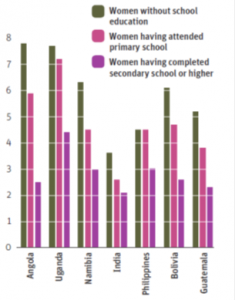-
Education as a Conservation Strategy – Really?

The original version of this article appeared in The Nature Conservancy’s October issue of their Science Chronicles newsletter.
It seems like everywhere you turn recently, you hear how the planet’s population is headed to 10 billion. And obvious questions follow: How can we balance far more people with the natural resources needed for their survival? How will we get more food? How will we get more energy?
In this piece, we argue that compelling new data and lessons learned from years of work around the globe suggests that conservation groups – including our own, The Nature Conservancy – should think hard about adopting another global priority strategy: education, especially education of young women in developing countries.
Seeing Is Believing
Our assumption is that most conservationists will be skeptical. We were too. So let’s see if we can alter your perspective by taking you first to Tanzania. In true Nature Conservancy place-based fashion, there is a stunning conservation area that provided the initial attraction – only later were the alarming statistics related to population and human well-being discovered that helped open our eyes to the importance of education.
On Tanzania’s western boundary, the Conservancy’s Africa program has a project to conserve a vast forested area with the rugged Mahale Mountain National Park at its core. In addition to containing approximately 90 percent of the chimpanzees in the country and other Africa icons like elephants, the project area also captures a significant portion of the Lake Tanganyika coastline. Lake Tanganyika is a true freshwater biodiversity gem. It has not only some of the most spectacular fish diversity on the globe, it also holds – in one lake – nearly as much fresh water as all the U.S. Great Lakes combined. But to successfully conserve the fish and chimps, complex conservation issues must be addressed.
In this remote region, people are almost entirely dependent on fishing and farming. When people can’t get enough food from the lake, they turn to the forest for hunting and to clear new land for farming. When there are too many people for the natural resource base, both the lake and the forest suffer. To get a better handle on these underlying land- and water-use issues, we conducted a baseline socioeconomic survey of the 50,000 people who live in the area (Hess & Leisher 2010). What we found startled us. The 10 villages on the edge of the lake bordering the national park had some eye-opening numbers:
- 49 percent of the population is under the age of 15, among the highest percentages for that cohort in the world.
- The average household size of 6.7 is 29 percent higher than the 2010 Tanzania average of 5.2 and among the highest in the world.
- 130 of every 1,000 children born locally between July and December 2006 did not survive to their 5th birthday, giving the villages an under-age-five mortality among the highest in the world.
This baseline social science survey made the conservation challenge clear: If we can’t address rapid human population growth in the area, we will not succeed in conserving the lands and water on which all local life depends.
Demography Is Not Destiny
A common reaction to the data is that, given such overwhelming population pressures, is there any reason for hope?
 Why is this important? Because the projections of Earth reaching 10 billion people span a longer timeframe than it took South Korea to dramatically alter its demographic profile.
Why is this important? Because the projections of Earth reaching 10 billion people span a longer timeframe than it took South Korea to dramatically alter its demographic profile.To find such reason, we have to journey to the other side of the globe – to South Korea. The demographic structure of South Korea in 1960, with roughly half its population under the age of 15 and 6.3 children per woman, was similar to many developing countries in the world today and much like where we work in Tanzania. But in just 30 years, South Korea’s demographics changed from a youth-heavy population pyramid to a much more sustainable teardrop shape (Figure 1), with a growth rate at replacement level.
South Korea could be dismissed as an aberration because it has such a large and vibrant economy – think LG and Hyundai – but South Korea is not alone. Colombia, Morocco, and Bangladesh had similar demographic shifts in even less time. Imagine how much worse environmental crises in these countries would have been had they not transformed their population pyramids? Rather than continue with the sole focus on more mouths needing more inputs, why not also adopt strategies that result in fewer mouths? Our argument is that population size and growth – and the increased consumption that comes with more people – does matter, and that conservation needs to address this challenge. These examples of dramatic demographic change show that it is possible to take the fuse out of the population bomb.
A recent report from Lilli Sippel et al. from the Berlin Institute for Population and Development looked at the demographic challenges in Africa and what factors contribute to a reduced population growth rate. Education – in particular educating women – was one of the most significant factors for reducing population growth rates. In the figure below, they show how increased education levels result in fewer births per woman. This study also calls out education as the key factor for greater economic development, which is a necessity for sustaining the benefits to an older population.
Investing in Women Pays
 The third stop on our journey takes us to the library to look at what we have learned from a half- century of international development. A meta-analysis of 26 countries from Teresa Castro Martin and Fatima Juarez dove-tails with Sippel et al.’s findings: educating women reduces the number of children, and even completing primary school was enough to make a significant difference. Educating women also had one of the highest returns on investment rates among all development initiatives. In sub-Saharan Africa, for example, the return on investment for completing primary school ranges from 25 percent to 38 percent. This means every $1 invested in primary education returns $1.25 to $1.38 to the community economically.
The third stop on our journey takes us to the library to look at what we have learned from a half- century of international development. A meta-analysis of 26 countries from Teresa Castro Martin and Fatima Juarez dove-tails with Sippel et al.’s findings: educating women reduces the number of children, and even completing primary school was enough to make a significant difference. Educating women also had one of the highest returns on investment rates among all development initiatives. In sub-Saharan Africa, for example, the return on investment for completing primary school ranges from 25 percent to 38 percent. This means every $1 invested in primary education returns $1.25 to $1.38 to the community economically.For comparison, consider this: Primary education’s return on investment was even greater than child vaccinations, which itself is the best buy for the money in the health sector. When poor women in developing countries earn income, they spend most of it on their families, creating a positive feedback loop that helps the next generation to be more educated and healthy.
Our final stop visits an apparently odd correlation: education and climate change. The UN posited in 2009 that educating women about reproductive health and providing them with family planning options would do more for reducing greenhouse gas emissions than stopping all deforestation. Education reduces population growth rate, which reduces growth in consumption, which in turn reduces greenhouse gas emissions. REDD+ is cool – but educating women is even cooler for global warming. Literally.
What Can Conservation Organizations Do?
Back in Mahale, Tanzania, we can see how its remoteness has been a blessing and a curse. Remoteness has helped to protect these special habitats from destructive human development. However, the people have also been virtually forgotten by government health and education programs. Yet even in apparently dire situations like this, education is critical to finding hope, and it’s a hope supported by data.
If you’re mentally jet-lagged after our strange trip from Tanzania to South Korea and back, the idea is simple: a wealth of data suggest that education, in particular educating women, could be one of conservation’s most important and successful strategies.
So what might some of these “education strategies” look like? Here is one possible pathway to the education frontier tailored to the talents of conservation organizations:
- Develop education strategies for the countries you work in that have an expansive (youth-heavy) population pyramid. In these countries, 35 percent or more of the population are under the age of 15, and these population demographics threaten to nullify the potential conservation gains planned for the next 50 years.
- In each of these countries, team up with respected family planning and reproductive health partners. Together, advance priority projects where population, health, and environment (PHE) actions are developed – collaboratively – from the beginning. Your organization does not have to be the expert here, but you can and should leverage expertise already available. In Mahale, The Nature Conservancy has a partnership with Pathfinder International, the leading human and reproductive health organization in Tanzania.
- In projects where a PHE approach is adopted, insure that education focuses on strategies that directly target young women. Again, this is why partnerships are important – they should bring knowledge of which strategies have worked best for the socioeconomic situation of each project.
- Support government funding for primary and secondary education for women. Government relations efforts in countries where PHE projects are being advanced should support education in its broadest sense. Increased access to education should amplify local conservation benefits.
Still skeptical?
Tim Tear is a senior scientist for The Nature Conservancy’s Africa Region and New York program. His recent research focuses on prioritization, air pollution impacts, and carbon sequestration in grasslands. Craig Leisher is a senior social scientist for The Nature Conservancy’s Central Science unit, focusing on measuring the impacts on people from conservation initiatives.
Sources: Berlin Institute for Population and Development, Bloom et al. (2005), Borges (2007), Hess et al. (2011), Kaiser Family Foundation, Laxminarayan et al. (2008), MEASURE DHS, Psacharopoulos et al. (2004), UN Population Fund, UN Population Division, World Bank.
Photo Credit: Swema Kabliya walks to get water in the village of Nkonkwa, on Lake Tanganyika in Tanzania, used with permission courtesy of Ami Vitale/The Nature Conservancy. Charts: Berlin Institute for Population and Development.
 A Publication of the Stimson Center.
A Publication of the Stimson Center.





